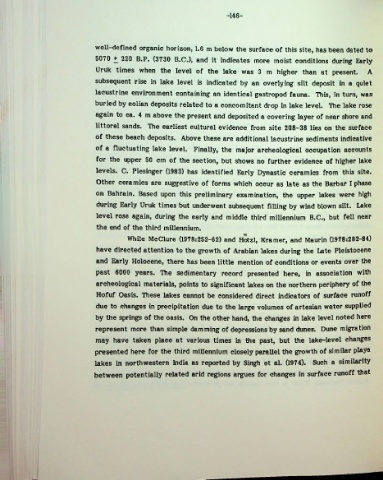Page 170 - Life & Land Use on the Bahrain Islands (Curtis E Larsen)
P. 170
-146-
well-defined organic horizon, 1.6 m below the surface of this site, has been dated to
5070 + 220 B.P. (3730 B.C.), and it indicates more moist conditions during Early
Uruk times when the level of the lake was 3 m higher than at present. A
subsequent rise in lake level is indicated by an overlying silt deposit in a quiet
lacustrine environment containing an identical gastropod fauna. This, in turn, was
buried by eolian deposits related to a concomitant drop in lake level. The lake rose
again to ca. 4 m above the present and deposited a covering layer of near shore and
littoral sands. The earliest cultural evidence from site 208-38 lies on the surface
of these beach deposits. Above these are additional lacustrine sediments indicative
of a fluctuating lake level. Finally, the major archeological occupation accounts
for the upper 50 cm of the section, but shows no further evidence of higher lake
levels. C. Piesinger (1983) has identified Early Dynastic ceramics from this site.
Other ceramics are suggestive of forms which occur as late as the Barbar I phase
on Bahrain. Based upon this preliminary examination, the upper lakes were high
during Early Uruk times but underwent subsequent filling by wind blown silt. Lake
level rose again, during the early and middle third millennium B.C., but fell near
the end of the third millennium.
While McClure (1978:252-62) and Hotzl, Kramer, and Maurin (1978:282-84)
have directed attention to the growth of Arabian lakes during the Late Pleistocene
and Early Holocene, there has been little mention of conditions or events over the
past 6000 years. The sedimentary record presented here, in association with
archeological materials, points to significant lakes on the northern periphery of the
Hofuf Oasis. These lakes cannot be considered direct indicators of surface runoff
due to changes in precipitation due to the large volumes of artesian water supplied
by the springs of the oasis. On the other hand, the changes in lake level noted here
represent more than simple damming of depressions by sand dunes. Dune migration
may have taken place at various times in the past, but the lake-level changes
presented here for the third millennium closely parallel the growth of similar playa
lakes in northwestern India as reported by Singh et al. (1974). Such a similarity
between potentially related arid regions argues for changes in surface runoff that

